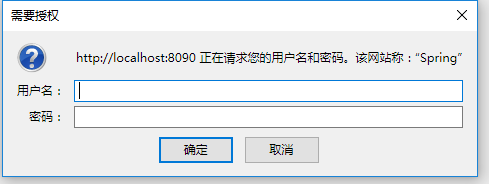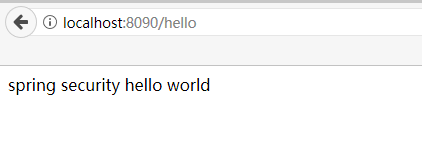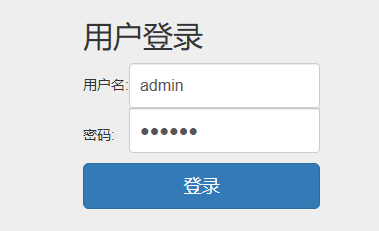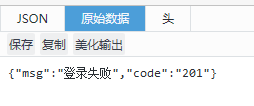找到了一篇好的博文,就转载了过来,文章有点长,希望可以有耐心的看下去。
一、Spring security 是什么?
Spring Security是一个能够为基于Spring的企业应用系统提供声明式的安全访问控制解决方案的安全框架。
它提供了一组可以在Spring应用上下文中配置的Bean,充分利用了Spring IoC,DI(控制反转Inversion of Control ,DI:Dependency Injection 依赖注入)和AOP(面向切面编程)功能,为应用系统提供声明式的安全访问控制功能,减少了为企业系统安全控制编写大量重复代码的工作。
二、Spring security 怎么使用?
使用Spring Security很简单,只要在pom.xml文件中,引入spring security的依赖就可以了。
<!-- spring security依赖 -->
<dependency>
<groupId>org.springframework.boot</groupId>
<artifactId>spring-boot-starter-security</artifactId>
</dependency>什么都不做,直接运行程序,这时你访问任何一个URL,都会弹出一个“需要授权”的验证框,如图:
,spring security 会默认使用一个用户名为:user 的用户,密码就是 启动的时候生成的(通过控制台console中查看),如图
然后在用户名中输入:user 密码框中输入 上面的密码 ,之后就可以正常访问之前URL了。很显然这根本不是我们想要的,接下来我们需要一步一步的改造。
改造1 使用页面表单登录
通过修改Security的配置来实现
首先 添加一个类 SecurityConfig 继承 WebSecurityConfigurerAdapter ,
重写configure方法。
并加上@Configuration 和@EnableWebSecurity 2个注解。
@Configuration
@EnableWebSecurity
public class SecurityConfig extends WebSecurityConfigurerAdapter {
@Override
protected void configure(HttpSecurity http) throws Exception {
// TODO Auto-generated method stub
//super.configure(http);
http
.formLogin().loginPage("/login").loginProcessingUrl("/login/form").failureUrl("/login-error").permitAll() //表单登录,permitAll()表示这个不需要验证 登录页面,登录失败页面
.and()
.authorizeRequests().anyRequest().authenticated()
.and()
.csrf().disable();
}
}View Code
loginPage("/login")表示登录时跳转的页面,因为登录页面我们不需要登录认证,所以我们需要添加 permitAll() 方法。
添加一个控制器,对应/login 返回一个登录页面。
@RequestMapping("/login")
public String userLogin()
{
return "demo-sign";
}html页面是使用 thymeleaf 模板引擎的,这里就不详细讲解了。
demo_sign.html 的 html部分代码如下:
<form class="form-signin" action="/login/form" method="post">
<h2 class="form-signin-heading">用户登录</h2>
<table>
<tr>
<td>用户名:</td>
<td><input type="text" name="username" class="form-control" placeholder="请输入用户名"/></td>
</tr>
<tr>
<td>密码:</td>
<td><input type="password" name="password" class="form-control" placeholder="请输入密码" /></td>
</tr>
<tr>
<td colspan="2">
<button type="submit" class="btn btn-lg btn-primary btn-block" >登录</button>
</td>
</tr>
</table>
</form>需要注意下:form提交的url要和配置文件中的 loginProcessingUrl("")中的一致。
failureUrl=表示登录出错的页面,我们可以简单写个提示:如 用户名或密码错误。
@RequestMapping("/login-error")
public String loginError()
{
return "login-error";
}login-error.html
<!DOCTYPE HTML>
<html xmlns="http://www.w3.org/1999/xhtml"
xmlns:th="http://www.thymeleaf.org">
<head>
<title>用户登录</title>
<link rel="stylesheet" href="https://cdn.bootcss.com/bootstrap/3.3.7/css/bootstrap.min.css" />
<link rel="stylesheet" href="/css/sign.css" />
</head>
<body>
<h3>用户名或密码错误</h3>
</body>
</html>
<html xmlns="http://www.w3.org/1999/xhtml"
xmlns:th="http://www.thymeleaf.org">
<head>
<title>用户登录</title>
<link rel="stylesheet" href="https://cdn.bootcss.com/bootstrap/3.3.7/css/bootstrap.min.css" />
<link rel="stylesheet" href="/css/sign.css" />
</head>
<body>
<h3>用户名或密码错误</h3>
</body>
</html>运行程序:如果输入错误的用户名和密码的话,则会显示如下图所示:
我们用一个测试的RestController来测试
@RestController
public class HelloWorldController {
@RequestMapping("/hello")
public String helloWorld()
{
return "spring security hello world";
}
}当没有登录时,输入 http://localhost:port/hello 时,则直接跳转到我们登录页面,登录成功之后,再访问 时,就能显示我们期望的值了。
改造2、自定义用户名和密码
很显然,这样改造之后,虽然登录页面是好看了,但还远远不能满足我们的应用需求,所以第二步,我们改造自定义的用户名和密码。
自定义用户名和密码有2种方式,一种是在代码中写死,这也是官方的demo,另一种是使用数据库
首先是第一种:如
@Autowired
public void configureGlobal(AuthenticationManagerBuilder auth) throws Exception {
auth
.inMemoryAuthentication()
.withUser("user").password("password").roles("USER");
}我们也照样,这是把用户名改成 admin 密码改成 123456 roles是该用户的角色,我们后面再细说。
@Autowired
public void configureGlobal(AuthenticationManagerBuilder auth) throws Exception {
auth
.inMemoryAuthentication()
.withUser("admin").password("123456").roles("USER");
}
@Autowired
public void configureGlobal(AuthenticationManagerBuilder auth) throws Exception {
auth
.inMemoryAuthentication()
.withUser("admin").password("123456").roles("USER");
}还有种方法 就是 重写 另外一种configure(AuthenticationManagerBuilder auth) 方法,这个和上面那个方法的作用是一样的。选其一就可。
@Override
protected void configure(AuthenticationManagerBuilder auth) throws Exception {
// TODO Auto-generated method stub
auth
.inMemoryAuthentication()
.withUser("admin").password("123456").roles("USER")
.and()
.withUser("test").password("test123").roles("ADMIN");
}程序运行起来,这时用我们自己的用户名和密码 输入 admin 和123456 就可以了。
你也可以多几个用户,就多几个withUser即可。
.and().withUser("test").password("test123").roles("ADMIN"); 这样我们就有了一个用户名为test,密码为test123的用户了。
第一种的只是让我们体验了一下Spring Security而已,我们接下来就要提供自定义的用户认证机制及处理过程。
在讲这个之前,我们需要知道spring security的原理,spring security的原理就是使用很多的拦截器对URL进行拦截,以此来管理登录验证和用户权限验证。
用户登陆,会被AuthenticationProcessingFilter拦截,调用AuthenticationManager的实现,而且AuthenticationManager会调用ProviderManager来获取用户验证信息(不同的Provider调用的服务不同,因为这些信息可以是在数据库上,可以是在LDAP服务器上,可以是xml配置文件上等),如果验证通过后会将用户的权限信息封装一个User放到spring的全局缓存SecurityContextHolder中,以备后面访问资源时使用。
所以我们要自定义用户的校验机制的话,我们只要实现自己的AuthenticationProvider就可以了。在用AuthenticationProvider 这个之前,我们需要提供一个获取用户信息的服务,实现 UserDetailsService 接口
用户名密码->(Authentication(未认证) -> AuthenticationManager ->AuthenticationProvider->UserDetailService->UserDetails->Authentication(已认证)
了解了这个原理之后,我们就开始写代码
第一步:我们定义自己的用户信息类 UserInfo 继承UserDetails和Serializable接口
代码如下:
public class UserInfo implements Serializable, UserDetails {
/**
*
*/
private static final long serialVersionUID = 1L;
private String username;
private String password;
private String role;
private boolean accountNonExpired;
private boolean accountNonLocked;
private boolean credentialsNonExpired;
private boolean enabled;
public UserInfo(String username, String password, String role, boolean accountNonExpired, boolean accountNonLocked,
boolean credentialsNonExpired, boolean enabled) {
// TODO Auto-generated constructor stub
this.username = username;
this.password = password;
this.role = role;
this.accountNonExpired = accountNonExpired;
this.accountNonLocked = accountNonLocked;
this.credentialsNonExpired = credentialsNonExpired;
this.enabled = enabled;
}
// 这是权限
@Override
public Collection<? extends GrantedAuthority> getAuthorities() {
// TODO Auto-generated method stub
return AuthorityUtils.commaSeparatedStringToAuthorityList(role);
}
@Override
public String getPassword() {
// TODO Auto-generated method stub
return password;
}
@Override
public String getUsername() {
// TODO Auto-generated method stub
return username;
}
@Override
public boolean isAccountNonExpired() {
// TODO Auto-generated method stub
return accountNonExpired;
}
@Override
public boolean isAccountNonLocked() {
// TODO Auto-generated method stub
return accountNonLocked;
}
@Override
public boolean isCredentialsNonExpired() {
// TODO Auto-generated method stub
return credentialsNonExpired;
}
@Override
public boolean isEnabled() {
// TODO Auto-generated method stub
return enabled;
}
}View Code
然后实现第2个类 UserService 来返回这个UserInfo的对象实例
public class MyUserDetailsService implements UserDetailsService {
@Override
public UserDetails loadUserByUsername(String username) throws UsernameNotFoundException {
// TODO Auto-generated method stub
//这里可以可以通过username(登录时输入的用户名)然后到数据库中找到对应的用户信息,并构建成我们自己的UserInfo来返回。
return null;
}
}
// TODO Auto-generated method stub
//这里可以通过数据库来查找到实际的用户信息,这里我们先模拟下,后续我们用数据库来实现
if(username.equals("admin"))
{
//假设返回的用户信息如下;
UserInfo userInfo=new UserInfo("admin", "123456", "ROLE_ADMIN", true,true,true, true);
return userInfo;
}
return null;View Code
到这里为止,我们自己定义的UserInfo类和从数据库中返回具体的用户信息已经实现,接下来我们要实现的,我们自己的 AuthenticationProvider
新建类 MyAuthenticationProvider 继承AuthenticationProvider
完整的代码如下:
@Component
public class MyAuthenticationProvider implements AuthenticationProvider {
/**
* 注入我们自己定义的用户信息获取对象
*/
@Autowired
private UserDetailsService userDetailService;
@Override
public Authentication authenticate(Authentication authentication) throws AuthenticationException {
// TODO Auto-generated method stub
String userName = authentication.getName();// 这个获取表单输入中返回的用户名;
String password = (String) authentication.getPrincipal();// 这个是表单中输入的密码;
// 这里构建来判断用户是否存在和密码是否正确
UserInfo userInfo = (UserInfo) userDetailService.loadUserByUsername(userName); // 这里调用我们的自己写的获取用户的方法;
if (userInfo == null) {
throw new BadCredentialsException("用户名不存在");
}
// //这里我们还要判断密码是否正确,实际应用中,我们的密码一般都会加密,以Md5加密为例
// Md5PasswordEncoder md5PasswordEncoder=new Md5PasswordEncoder();
// //这里第个参数,是salt
// 就是加点盐的意思,这样的好处就是用户的密码如果都是123456,由于盐的不同,密码也是不一样的,就不用怕相同密码泄漏之后,不会批量被破解。
// String encodePwd=md5PasswordEncoder.encodePassword(password, userName);
// //这里判断密码正确与否
// if(!userInfo.getPassword().equals(encodePwd))
// {
// throw new BadCredentialsException("密码不正确");
// }
// //这里还可以加一些其他信息的判断,比如用户账号已停用等判断,这里为了方便我接下去的判断,我就不用加密了。
//
//
if (!userInfo.getPassword().equals("123456")) {
throw new BadCredentialsException("密码不正确");
}
Collection<? extends GrantedAuthority> authorities = userInfo.getAuthorities();
// 构建返回的用户登录成功的token
return new UsernamePasswordAuthenticationToken(userInfo, password, authorities);
}
@Override
public boolean supports(Class<?> authentication) {
// TODO Auto-generated method stub
// 这里直接改成retrun true;表示是支持这个执行
return true;
}
}View Code
到此为止,我们的用户信息的获取,校验部分已经完成了。接下来要让它起作用,则我们需要在配置文件中修改,让他起作用。回到我的SecurityConfig代码文件,修改如下:
1、注入我们自己的AuthenticationProvider
2、修改配置的方法:
@Autowired
private AuthenticationProvider provider; //注入我们自己的AuthenticationProvider
@Override
protected void configure(AuthenticationManagerBuilder auth) throws Exception {
// TODO Auto-generated method stub
auth.authenticationProvider(provider);
// auth
// .inMemoryAuthentication()
// .withUser("admin").password("123456").roles("USER")
// .and()
// .withUser("test").password("test123").roles("ADMIN");
}
@Autowired
private AuthenticationProvider provider; //注入我们自己的AuthenticationProvider
@Override
protected void configure(AuthenticationManagerBuilder auth) throws Exception {
// TODO Auto-generated method stub
auth.authenticationProvider(provider);
// auth
// .inMemoryAuthentication()
// .withUser("admin").password("123456").roles("USER")
// .and()
// .withUser("test").password("test123").roles("ADMIN");
}View Code
现在重新运行程序,则需要输入用户名为 admin 密码是123456之后,才能正常登录了。
为了方便测试,我们调整添加另一个控制器 /whoim 的代码 ,让他返回当前登录的用户信息,前面说了,他是存在SecurityContextHolder 的全局变量中,所以我们可以这样获取
@RequestMapping("/whoim")
public Object whoIm()
{
return SecurityContextHolder.getContext().getAuthentication().getPrincipal();
}View Code
我们运行,直接反问 /whoim ,则直接跳转到登录页面,我们验证过之后,再访问此url,结果如下:
到这里,我们自定义的登录已经成功了。
改造3、自定义登录成功和失败的处理逻辑
在现在的大多数应用中,一般都是前后端分离的,所以我们登录成功或失败都需要用json格式返回,或者登录成功之后,跳转到某个具体的页面。
接下来我们来实现这种改造。
为了实现这个功能,我们需要写2个类,分别继承SavedRequestAwareAuthenticationSuccessHandler和SimpleUrlAuthenticationFailureHandler2个类,并重写其中的部分方法即可。
//处理登录成功的。
@Component("myAuthenticationSuccessHandler")
public class MyAuthenticationSuccessHandler extends SavedRequestAwareAuthenticationSuccessHandler{
@Autowired
private ObjectMapper objectMapper;
@Override
public void onAuthenticationSuccess(HttpServletRequest request, HttpServletResponse response, Authentication authentication)
throws IOException, ServletException {
//什么都不做的话,那就直接调用父类的方法
super.onAuthenticationSuccess(request, response, authentication);
//这里可以根据实际情况,来确定是跳转到页面或者json格式。
//如果是返回json格式,那么我们这么写
Map<String,String> map=new HashMap<>();
map.put("code", "200");
map.put("msg", "登录成功");
response.setContentType("application/json;charset=UTF-8");
response.getWriter().write(objectMapper.writeValueAsString(map));
//如果是要跳转到某个页面的,比如我们的那个whoim的则
new DefaultRedirectStrategy().sendRedirect(request, response, "/whoim");
}
}View Code
//登录失败的
@Component("myAuthenticationFailHander")
public class MyAuthenticationFailHander extends SimpleUrlAuthenticationFailureHandler {
@Autowired
private ObjectMapper objectMapper;
private Logger logger = LoggerFactory.getLogger(getClass());
@Override
public void onAuthenticationFailure(HttpServletRequest request, HttpServletResponse response,
AuthenticationException exception) throws IOException, ServletException {
// TODO Auto-generated method stub
logger.info("登录失败");
//以Json格式返回
Map<String,String> map=new HashMap<>();
map.put("code", "201");
map.put("msg", "登录失败");
response.setStatus(HttpStatus.INTERNAL_SERVER_ERROR.value());
response.setContentType("application/json");
response.setCharacterEncoding("UTF-8");
response.getWriter().write(objectMapper.writeValueAsString(map));
}
}View Code
代码完成之后,修改配置config类代码。
添加2个注解,自动注入
@Autowired
private AuthenticationSuccessHandler myAuthenticationSuccessHandler;
@Autowired
private AuthenticationFailureHandler myAuthenticationFailHander;
@Override
protected void configure(HttpSecurity http) throws Exception {
// TODO Auto-generated method stub
//super.configure(http);
http
.formLogin().loginPage("/login").loginProcessingUrl("/login/form")
.successHandler(myAuthenticationSuccessHandler)
.failureHandler(myAuthenticationFailHander)
.permitAll() //表单登录,permitAll()表示这个不需要验证 登录页面,登录失败页面
.and()
.authorizeRequests().anyRequest().authenticated()
.and()
.csrf().disable();
}
View Code
进行测试,我们先返回json格式的(登录成功和失败的)
改成跳转到默认页面
改造4、添加权限控制
之前的代码我们用户的权限没有加以利用,现在我们添加权限的用法。
之前的登录验证通俗的说,就是来判断你是谁(认证),而权限控制就是用来确定:你能做什么或者不能做什么(权限)
在讲这个之前,我们简单说下,对于一些资源不需要权限认证的,那么就可以在Config中添加 过滤条件,如:
@Override
protected void configure(HttpSecurity http) throws Exception {
// TODO Auto-generated method stub
//super.configure(http);
http
.formLogin().loginPage("/login").loginProcessingUrl("/login/form")
.successHandler(myAuthenticationSuccessHandler)
.failureHandler(myAuthenticationFailHander)
.permitAll() //表单登录,permitAll()表示这个不需要验证 登录页面,登录失败页面
.and()
.authorizeRequests()
.antMatchers("/index").permitAll() //这就表示 /index这个页面不需要权限认证,所有人都可以访问
.anyRequest().authenticated()
.and()
.csrf().disable();
}View Code
那么我们直接访问 /index 就不会跳转到登录页面,这样我们就可以把一些不需要验证的资源以这种方式过滤,比如图片,脚本,样式文件之类的。
我们先来看第一种:在编码中写死的。
那其实权限控制也是通过这种方式来实现:
http
.formLogin().loginPage("/login").loginProcessingUrl("/login/form")
.successHandler(myAuthenticationSuccessHandler)
.failureHandler(myAuthenticationFailHander)
.permitAll() //表单登录,permitAll()表示这个不需要验证 登录页面,登录失败页面
.and()
.authorizeRequests()
.antMatchers("/index").permitAll()
.antMatchers("/whoim").hasRole("ADMIN") //这就表示/whoim的这个资源需要有ROLE_ADMIN的这个角色才能访问。不然就会提示拒绝访问
.anyRequest().authenticated() //必须经过认证以后才能访问
.and()
.csrf().disable();
.formLogin().loginPage("/login").loginProcessingUrl("/login/form")
.successHandler(myAuthenticationSuccessHandler)
.failureHandler(myAuthenticationFailHander)
.permitAll() //表单登录,permitAll()表示这个不需要验证 登录页面,登录失败页面
.and()
.authorizeRequests()
.antMatchers("/index").permitAll()
.antMatchers("/whoim").hasRole("ADMIN") //这就表示/whoim的这个资源需要有ROLE_ADMIN的这个角色才能访问。不然就会提示拒绝访问
.anyRequest().authenticated() //必须经过认证以后才能访问
.and()
.csrf().disable(); View Code
这个用户的角色哪里来,就是我们自己的UserDetailsService中返回的用户信息中的角色权限信息,这里需要注意一下就是 .hasRole("ADMIN"),那么给用户的角色时就要用:ROLE_ADMIN
.antMatchers 这里也可以限定HttpMethod的不同要求不同的权限(用于适用于Restful风格的API).
如:Post需要 管理员权限,get 需要user权限,我们可以这么个改造,同时也可以通过通配符来是实现 如:/user/1 这种带参数的URL
.antMatchers("/whoim").hasRole("ADMIN")
.antMatchers(HttpMethod.POST,"/user/*").hasRole("ADMIN")
.antMatchers(HttpMethod.GET,"/user/*").hasRole("USER")
Spring Security 的校验的原理:左手配置信息,右手登录后的用户信息,中间投票器。
从我们的配置信息中获取相关的URL和需要的权限信息,然后获得登录后的用户信息,
然后经过:AccessDecisionManager 来验证,这里面有多个投票器:AccessDecisionVoter,(默认有几种实现:比如:1票否决(只要有一个不同意,就没有权限),全票通过,才算通过;只要有1个通过,就全部通过。类似这种的。
WebExpressionVoter 是Spring Security默认提供的的web开发的投票器。(表达式的投票器)
Spring Security 默认的是 AffirmativeBased 只要有一个通过,就通过。
有兴趣的可以 从FilterSecurityInterceptor这个过滤器入口,来查看这个流程。
内嵌的表达式有:permitAll denyAll 等等。
每一个权限表达式都对应一个方法。
如果需要同时满足多个要求的,不能连写如 ,我们有个URL需要管理员权限也同时要限定IP的话,不能:.hasRole("ADMIN").hasIPAddress("192.168.1.1");
而是需要用access方法 .access("hasRole('ADMIN') and hasIpAddress('192.168.1.1')");这种。
那我们可以自己写权限表达式吗? 可以,稍后。。。这些都是硬编码的实现,都是在代码中写入的,这样的灵活性不够。所以我们接下来继续改造
改造4、添加基于RBAC(role-Based-access control)权限控制
这个大家可以去百度一下,一般都是由 3个部分组成,一个是用户,一个是角色 ,一个是资源(菜单,按钮),然后就是 用户和角色的关联表,角色和资源的关联表
核心就是判断当前的用户所拥有的URL是否和当前访问的URL是否匹配。
首先我们自己提供一个判断的接口和实现,代码如下:
/**
* 返回权限验证的接口
*
*
*/
public interface RbacService {
boolean hasPermission(HttpServletRequest request,Authentication authentication);
}
@Component("rbacService")
public class RbacServiceImpl implements RbacService {
private AntPathMatcher antPathMatcher = new AntPathMatcher();
@Override
public boolean hasPermission(HttpServletRequest request, Authentication authentication) {
Object principal = authentication.getPrincipal();
boolean hasPermission = false;
if (principal instanceof UserDetails) { //首先判断先当前用户是否是我们UserDetails对象。
String userName = ((UserDetails) principal).getUsername();
Set<String> urls = new HashSet<>(); // 数据库读取 //读取用户所拥有权限的所有URL
urls.add("/whoim");
// 注意这里不能用equal来判断,因为有些URL是有参数的,所以要用AntPathMatcher来比较
for (String url : urls) {
if (antPathMatcher.match(url, request.getRequestURI())) {
hasPermission = true;
break;
}
}
}
return hasPermission;
}
}View Code
然后在Security的配置项中添加自定义的权限表达式就可以了
@Override
protected void configure(HttpSecurity http) throws Exception {
// TODO Auto-generated method stub
//super.configure(http);
http
.formLogin().loginPage("/login").loginProcessingUrl("/login/form")
.successHandler(myAuthenticationSuccessHandler)
.failureHandler(myAuthenticationFailHander)
.permitAll() //表单登录,permitAll()表示这个不需要验证 登录页面,登录失败页面
.and()
.authorizeRequests()
// .antMatchers("/index").permitAll()
// .antMatchers("/whoim").hasRole("ADMIN")
// .antMatchers(HttpMethod.POST,"/user/*").hasRole("ADMIN")
// .antMatchers(HttpMethod.GET,"/user/*").hasRole("USER")
.anyRequest().access("@rbacService.hasPermission(request,authentication)") //必须经过认证以后才能访问
.and()
.csrf().disable();
}View Code
其中 @rbacService 就是我们自己声明的bean,在RbacServiceImpl实现类的头部注解中。
改造5、记住我的功能Remeber me
本质是通过token来读取用户信息,所以服务端需要存储下token信息
根据官方的文档,token可以通过数据库存储 数据库脚本
CREATE TABLE persistent_logins (
username VARCHAR(64) NOT NULL,
series VARCHAR(64) NOT NULL,
token VARCHAR(64) NOT NULL,
last_used TIMESTAMP NOT NULL,
PRIMARY KEY (series)
);然后,配置好token 的存储 及数据源
@Autowired
private DataSource dataSource; //是在application.properites
/**
* 记住我功能的token存取器配置
* @return
*/
@Bean
public PersistentTokenRepository persistentTokenRepository() {
JdbcTokenRepositoryImpl tokenRepository = new JdbcTokenRepositoryImpl();
tokenRepository.setDataSource(dataSource);
return tokenRepository;
}
@Autowired
private DataSource dataSource; //是在application.properites
/**
* 记住我功能的token存取器配置
* @return
*/
@Bean
public PersistentTokenRepository persistentTokenRepository() {
JdbcTokenRepositoryImpl tokenRepository = new JdbcTokenRepositoryImpl();
tokenRepository.setDataSource(dataSource);
return tokenRepository;
}View Code
修改Security配置
@Override
protected void configure(HttpSecurity http) throws Exception {
// TODO Auto-generated method stub
//super.configure(http);
http
.formLogin().loginPage("/login").loginProcessingUrl("/login/form")
.successHandler(myAuthenticationSuccessHandler)
.failureHandler(myAuthenticationFailHander)
.permitAll() //表单登录,permitAll()表示这个不需要验证 登录页面,登录失败页面
.and()
.rememberMe()
.rememberMeParameter("remember-me").userDetailsService(userDetailsService)
.tokenRepository(persistentTokenRepository())
.tokenValiditySeconds(60)
.and()
.authorizeRequests()
// .antMatchers("/index").permitAll()
// .antMatchers("/whoim").hasRole("ADMIN")
// .antMatchers(HttpMethod.POST,"/user/*").hasRole("ADMIN")
// .antMatchers(HttpMethod.GET,"/user/*").hasRole("USER")
.anyRequest().access("@rbacService.hasPermission(request,authentication)") //必须经过认证以后才能访问
.and()
.csrf().disable(); View Code
登录之后 数据库就会有一条数据
然后,服务重新启动下,我们在看下直接访问 /whoim 的话,就可以直接访问了,不需要再登录了。
到此为止我们的Spring Securtiy 的基本用法已经改造完成了。
@转载,侵删.










